 c335,000 active duty personnel, c480 ships, c2,600 aircraft (motto “Semper Fortis”)
c335,000 active duty personnel, c480 ships, c2,600 aircraft (motto “Semper Fortis”)
The USN Today
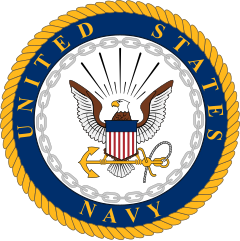
This large new section is discussing the US Navy from the fall of USSR in 1991 to this day and age (2025), prospects until 2030+ and current challenges facing the international, geopolitical situation. It is clear that recent developments of the war in Ukraine, and stance of China in the South China Sea poses the Pentagon serious considerations for the future global status of the US, regardless of the administration, and this goes with the Navy assets and capabilities. There had been serious critics about the post-cold war USN procurement, with many programs raising considerable controversy, and serious cost overruns leading to cancellations.
The three examples here most symptomatic of the 1990-2000s decades are the Zumwalt class destroyers, perhaps too ambitious for their own good, and with sub programs massively over schedule and over budgets, gradual decrease in capabilities and extra delays. So far the Zumwalt class are now considered white elephants, and the initially generous program was curtailed to just three units, the third being not even fully operational.
The second controversial program is on the “lighter” side, as the Litoral Combat Ships of LCS divided into the Independence class (trimaran hull) and Freedom class (single hulls), probably the most famous of this post-cold war new doctrine of regional crisis and asymetric threats. Fukuyama’s “end of history” seemed confirmed with a claimed “victory” over USSR, a Soviet Navy down to the bone, and China still not a threat at this point.
The doctrine for these ships, initially thought as very modular and inexpensive, were clearly peacetime missions: Patrolling, port visits, anti-piracy, and partnership-building exercises and mostly shore or shallow waters operations when first planned in the 1990s. In 2010 both designs were authorized and built, but they encountered a lot of operational issues. It was notably denounced their lack of firepower and usefulness in the waters of the Middle East. With the rapid rise of the PLAN it was clear they were under-armed and already a new class of fully fledged high seas frigates, something no longer in the inventory since the OH perry, was planned, the future constellation class frigates.
But the latter recently experienced scores of construction delays, despite being built in the US on an existing design, the Italo-French FREMM.
In general, if the programs (Batch IV-V Burke, Virginia class, Columbian class submarines) proceeded according to plans, there has been great concerns about the state of US shipbuilding in general. Post Cold War budget cuts saw a number of cancelled orders and slowing down of all programs, and now that the USN is ramping up again, construction rates could not keep up with the demand created by the gradual decommission of the “legacy” Cold War fleet, such as the Ticonderoga class cruisers and some of the Nimitz class carriers, bedrock of the USN right now, which is planned for USS Nimitz (Commissioned 3 May 1975 and thus now half a century old) with the second ship of the new Ford class. As for now, she is scheduled for replacement by USS John F. Kennedy CVN-79 this year if all goes according to plan. Construction of USS Gerald R. Ford also raised eyebrows as a prototype with many innovations, starting with EMALS catapults, as she was laid down in November 2009, only launched in October 2013 and completed in July 2017 so eight years total. However, if this seems long, to compare, this was seven years for USS Nimitz and technology was far less advanced back then.
Published Articles:
As of March 2, 2025, here are the latest developments concerning the U.S. Navy:
USS Carl Vinson’s Port Call in South Korea:
The USS Carl Vinson, a nuclear-powered aircraft carrier, has arrived in Busan, South Korea. This visit underscores the strong military alliance between the U.S. and South Korea, especially in light of North Korea’s recent missile tests. The carrier is accompanied by the guided-missile cruiser USS Princeton and the USS Sterett guided-missile destroyer.
Norwegian Fuel Supplier’s Stance:
Norwegian company Haltbakk Bunkers has declined to supply fuel to U.S. warships, including the USS Delaware, in response to geopolitical tensions related to the Ukraine crisis. The company’s owner, Gunnar Gran, cited dissatisfaction with U.S. President Donald Trump’s recent actions concerning Ukraine as the reason for this decision. theaustralian.com.au
Navy Leadership Nominations:
President Trump has nominated Hung Cao, a retired Navy combat veteran, for the position of Navy undersecretary. Cao is known for his stance against diversity, equity, and inclusion initiatives in the military, advocating for a force composed of “alpha males and alpha females.” His nomination is expected to face rigorous scrutiny during the Senate confirmation process. politico.com
Submarine Shipbuilding Challenges:
John Phelan, nominated by President Trump for Secretary of the Navy, has outlined strategies to address delays and budget overruns in submarine construction. His approach includes revitalizing the U.S. industrial base by investing in shipyards, attracting talent to shipbuilding careers, and learning from international shipbuilding practices. businessinsider.com
Maritime Strategy Amidst Global Competition:
The U.S. is reassessing its maritime strategy due to growing tensions with China. Efforts are underway to rejuvenate the American merchant marine and shipbuilding industry, recognizing their importance to national security. Legislative proposals, such as the “SHIPS Act,” aim to bolster the U.S.’s maritime capabilities in response to China’s significant investments in its maritime sector.
USN vs. PLAN, who will win ?
The United States Navy (USN) as a maritime service branch of the United States Department of Defense is still today the most powerful navy, with the largest displacement at 4.5 million tons in 2021, but not the largest fleet in pure terms of ships. One elephant in the room given the current geopolitical context is its standing compare to the world’s second largest navy, the People’s Liberation Army Navy or PLAN. This comparison had been done to death in medias so i will simply underline key differences here:
-The PLAN has more ships indeed over 790 versus 300, but most are frigates and corvettes or coastal FAC(M).
-In terms of missile destroyers, the US has a clear advantage with the Arleigh Burke class, in numbers and homogeneity.
-Same for submarines. The PLAN had more, but most are smaller diesel-electric and AIP submarines, and only four SSBNs. The USN has only large SSNs, as well as around 14 SSBNs.
-For Aircraft carriers, this is not even a contest. The USN still has the world’s largest aircraft carrier fleet, with 11 in service, plus one in trials, two under construction, six planned. The PLAN currently has only three carriers, the oldest now officially a training carrier (sister ship of varyag of dubious use) with two STOBAR and only the last and third being larger and a CATOBAR (still not fully operational) with more planned. More so, they lacked the experience of the USN, going back to 1922, so more than 104 years.
Now, a fleet is nothing without its logistic support. The USN has as of 2024 a strenght of 336,978 personnel on active duty, 101,583 in the Ready Reserve. The PLAN has 384,000 active personnel as of 2025, all comprised, so roughly comparable, but it’s logistic fleet is simply in its infancy. The USN also possesses some 4,012 operational aircraft in 2023 versus PLAN’s 600, and a far larger amphibious fleet as well, in quantity and quality.
So even if the PLAN on paper is twice as large as the USN today, the quality is simply not there yet.
However there are some worrying prospects:
-First off, the USN in case of war, let say with Taiwan, could only concentrate so much of its assets locally, perhaps four CSGs and two Amphibious CGs.
-Second, there is a clear recruitment crisis (not unique to the US), partially compensated by more automation and efforts made in better pay and conditions, and sometimes a more lax discipline. In the 2000s for example they had been a number of poor maintenance cases and abnormal suicide rates.
-Third, there is clearly a shipbuilding imbalance between the US and China which had been underlines in many reports. US shipbuilding industry is strggling today to keep delays and costs, and simply deliver the goods. Reasons are multiple and complex, and they had been senate investigations and congress commissions to undeline some of these reasons.
The USN Stance Today

Pacific Rim exercise with the South Korean Navy
The United States Navy is not the oldest around, it traces however its root to the 1780s Continental Navy and American Revolutionary War, created its founding myths in the Barbary pirates war, and really started in 1794 with the creation of “super frigatesé, one of which is still active and comissioned today (see below). It saw a rapid rize and fall during and after the American Civil War, playing a vital role by blockading the Confederacy. It’s story bounced again building confidence in the 1898 war with Spain, played its role in WWI, even modest, but was instrumental for its survival in World War II to defeat Imperial Japan, emerging as the most powerful navy in the world, a status that was kept unchallenged for many decades.
Missions
The Navy must recruit, train, equip, and organize a combat ready Naval force operative in wartime as well as in peacetime, maintaining security and conventional as well as nuclear deterrence (via its SSBN) arm through “sustained forward presence”.
As stated by the U.S. Navy training manuals the overall mission is “to be prepared to conduct prompt and sustained combat operations in support of the national interest.” The USN must maintain its primacy on the global stage on sea control, power projection, deterrence, maritime security, and sealift.
The core missions of the USN today is still to maintain a global presence, maintaining at all times CSG or Carrier Strike Groups as the core of its active organization in areas such as the Western Pacific, Mediterranean, and Indian Ocean, ready to answer international crisis at any moment. The archetypal blue-water navy, project force on any corner of the world, and ready for forward deployments in peacetime as well as rapid response, this is the most visible actor in American foreign and military policy. The USN has its place in the Department of the Navy alongside the United States Marine Corps, but not the Coast Guard, which is dependent of the treasury. The secretary of the Navy is a civilian appointment, part of the nominations made by all new administration, subordonated to the Department of Defense headed by the secretary of defense. The chief of naval operations (CNO) is the most senior Navy officer and true link with carrier officers and whole adminstration of the USN.
Cold War Legacy
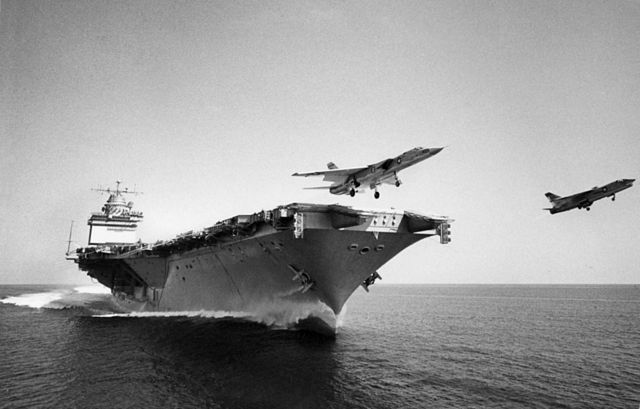
The massive A3J-1 Vigilante launched from USS Enteprise. In the late 1940s the USN tried to push the idea of projecting nuclear bombers from its carriers. As shown by the case of USS United States (CVA-58), the US Air Force won this round and futuristic models like the Vigilante were reconverted from bombers to fast long range reconnaissance assets.
Maintaining strength, and Decisive Deployments
Unlike many historical examples, the wartime inflation of a navy in wartime was followed by a radical peacetime decrease (like the Royal Navy during and after WW2), the USN was already the second largest in 1939, became by far the largest in 1945 and maintained its size even in the Cold War. If many plans and constructions had been cancelled in 1945, from 1947 the danger posed by the Soviet Union in what became the Cold War force the U.S. Navy to procure the “shield of the free world”, mostly protecting Europe and its allies across the globe, and maintain an edge in technological advances by developing new weapons systems.
The naval strategy soon adopted the emphasis on carrier battle groups, a versatile forward projection asset which is still at the core of USN doctrine today. The Navy had been pivotal in both the Korean and Vietnam War, as well as instrumental in blockading Cuba and help to solve the Cuban Missile Crisis.
Albeit there was clearly a deflation of budget post Vietnam, late Cold War operations still included the USN such as its Persian Gulf presence, against Iran in 1987-1988 and Operation Praying Mantis, post-cold war Urgent Fury, Desert Shield, Desert Storm, Deliberate Force, Allied Force, Desert Fox and Southern Watch. This was alongside peacetime roles such as inter-service and international fleet training, notably through the frame of NATO in the west, RIMPAC in the mid-Pacific theatre and UNITAS in South America.
Carrier Strike Groups
Formerly “CBG” or “Carrier Battle Groups” they are the bedrock today of US policy on all the seas, a true symbol of its power projection.
See: https://en.wikipedia.org/wiki/Carrier_strike_group
The pillar of US Nuclear Deterrence
The third aspect is the use of ballistic missile submarines and in general early inter-service rivalry on who would possess the primacy in nuclear deterrence. If initially the Navy in the 1950s lost to the US Air Force and was forced to concentrate on SSBNs, they won the long game as today the latter is the pillar of US nuclear deterrence, due to the fact this asset is both “permanent” and “invisible”.
Which was not the case of land based missiles, still extant for some, but largely seen as obsolete due to their fixed and known location, and a far more limited land tactical asset, while the Air Force, apart modernized Minuteman missiles, counts on its equally stealthy B-2 bombers, albeit in short supply, and its old school, but below radar Rockwell B-1B. Not counting its fleet of 70+ years old B-52s for traditional carpet bombing but also nuclear capable with cruise missiles.
SSBNs developed from the 1950s are now an important aspect of the United States’ nuclear strategic deterrence policy. The US possesses in that area, like for carriers, the greatest experience and numbers. In the cold war, the famous “41 for freedom” traduced the goal of maintaining a fleet of 41 SSBNs with half always at sea. The post-cold war budget cuts meant the USN reduced its sub fleet to the sole Ohio class SSBNs, which carried more missiles, and more MIRVs (20 × Trident II D5 SLBM x 12 MIRV each, 240 total). In theory, a single Ohio class sub deployed from the US east coast could strike all Soviet cities of large and medium size in one full launch.
In total, 24 were built, the first scheduled for decommission and replacement by the new Columbia class (see later). The latter goes back down to 16 missiles, the same Trident D5 as before, but with planned upgrade to the D6 and greater emphasis on strike and cruiser missiles. Some Ohio class had been, indeed treaty-wise, converted and reclassed as SSGNs, and due to their large silos could carry up to 154 Tomahawk cruise missiles. They could play a role similar to the ex-Soviet SSGNs such as the OSCAR class in a surface engagement, or more likely replace the long wanted alternative to vintage battleships of the Iowa class as a coastal bombardment asset for land operation (something attempted for the Zumwalt among others). The Tomahawk can strike (Block Vb) beyond 1035+ miles (1666 km, exact range classified). Even with assisted shells, a battleship would be limited to around 90km at best, and with arguably lower accuracy.
Dividends of Peace ?
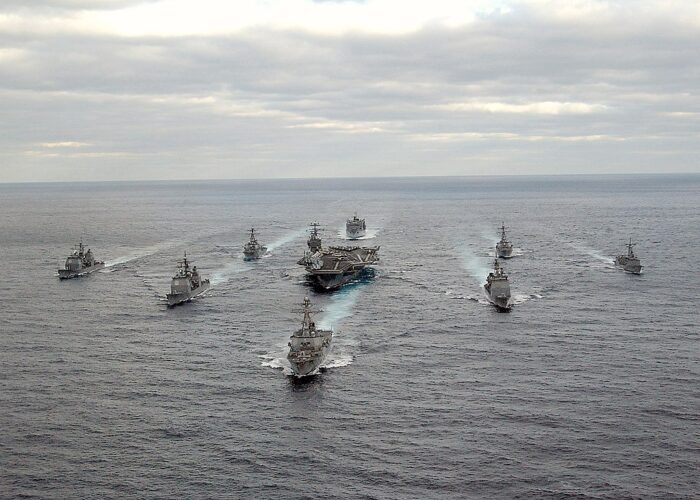
The U.S. Navy continues to be a major support to U.S. interests in the 21st century, shifting its focus from a large-scale war with the Soviet Navy to asymetric warfare, special operations, strike missions in regional crisis. If some assets remained “standard” and are not dicussed since the doctrine did not changed such as Gerald R. Ford-class aircraft carrier, Arleigh Burke class destroyers, and new SSN-SSBNs, the rest of the surface fleet was in disarray. The USN maintained for example an impressive fleet of cruisers until the very end of the cold war and beyond: Nine nuclear-powered (1 Long Beach, 2 California, 4 Virginia, 1 Truxtun and 1 Bainbrige), 45 conventionally-powered (9 Belknap, 9 Truxtun, 27 Ticonderoga). As of 2020, only the “Tico” remained. But unlike all the others they had the AEGIS system and cost less to operate. But even these are on the path of retirement (see later) wthout clear replacement albeit the Zumwalt class for many should be reclassed as destroyers. However the term “cruiser” for many is now obsolete as current Arleigh Burke class destroyers are equipped the same and even more capable in many ways.
This post cold war, “dividend of peace” effected more drastically Europe, by far, but it also impacted the USN with massive ships retirements, concentration on a few classes. But the most striking aspect of this massive decrease was on the field of smaller ships. During the whole cold war, the USN maintain a large fleet of frigates, which role was clearly defined as ASW assets. For many decades and until the end of the cold war, this means the Knox and then O.H. perry classes of frigates. If the Knox are now gone, many exported, on the 71 Oliver Hazard Perry built 1975-2004, “only” 45 remained. They are on the way out, provided enough of the new -and more capable- Constellation class could be provided. The difference between the two are massive, since the latter are far more capable in all direction (air sea, and undersea warfare) whereas the OH Perry were more ASW-oriented, as were the Spruance class destroyers. Both were of the same generation with a genesis in the Vietnam era to answer the growing SSN/SSGN and SSN fleet of nuclear-powered Soviet submarines, adding their numbers to an already massive (300+) conventional submarine fleet.
2000s Doctrine Change
The most symbolic vessels of these years of uncertainty were the Littoral combat ship. They were designed as semi-experimental vessels, not successors to Frigates, nor corvettes either, but very modular vessels fir for peacetime missions at lower cost: Maintaining international global order, safeguarding global trade and protecting allied nations. They were to be able to fulfill a large range of low-intensity missions, including surveillance, SAR, policing, and spec-cops. On 17 October 2007, the USN, U.S. Marine Corps and U.S. Coast Guard adopted a new maritime strategy, the “Cooperative Strategy for 21st Century Seapower”. In there was the notion of prevention of war in the same depth in operation than the conduct of war. It was basically a conventional deterrence policy at sea, a guarantee of “pax americana”. That strategy was presented by all three heads of these branches, the Chief of Naval Operations, Commandant of the Marine Corps, and Commandant of the Coast Guard, at the International Sea Power Symposium in Newport, Rhode Island.
This new strategy emphasis recoignized economic links of the US in the global economy and how to prevent any disruption in regional theaters, wether it be man-made or natural. All factors that could adversely impact the U.S. economy and quality of life. This the Navy, Coast Guard, and Marine Corps were supposed to work collectively with each other as well as coordinate international partners to prevent such crisis from even occurring, and if needed, to react quickly and restore order. It is not far away from the naval doctrine before WWI which ensured the prosperity of Great Britain.
In 2010, Admiral Gary Roughead as CNO noted however the effects of opost-cold war massive decommissions, conrasting to still unfliching demands on the Navy. He noted in fact, and against all attempts, they have grown. In the new context of declining budgets and seeingly more decommissions in the future, the U.S. Navy should rely more on international partnerships in each theater. This also went for a regular push from the US to ensure NATO kept it’s naval commitment, and actually reach a 2% GDP expenses. Indeed apart France and UK, traditional powers with a claimed global reach, Spain, Italy or Turkey were the only relatively sizeable naval powers of some importance that could supmenet the USN’s 6th fleet in the Med, but the Bundesmarine suffered greatly from post cold war shrinking and drastic drop in capabilities. Canada was also crititized for the same reasons.
The 2013 budget requested the navy was con strained to keep all eleven big deck carriers, even if its means reducung smaller ships, delaying SSBN replacement.But by 2014 just as the war flare up in Crimea, the USN was found unable to maintain eleven aircraft carriers after the Bipartisan Budget Act of 2013. Under CNO Jonathan Greenert, it was argued that a ten ship carrier fleet could just not fufill the expected presence and military requirements. First Sea Lord George Zambellas clearly underline the “resource-led” planning that affected the fleet.
From 2015 onwads alarms were raised at the contrasted picture of a shrunk USN strugging to fill its mission book, whereas the PLAN was clearly outpacing it. This was the “Pivot to East Asia”. Secretary of the Navy Ray Mabus stated that same year that 60% of the total U.S. fleet needed to be deployed to the Pacific by 2020 and a new, massive 30-year shipbuilding plan published by 2016 stressed out a fleet of 350 ships to meet these new challenges. A provision of the 2018 National Defense Authorization Act even added 5 more ships to this total “as soon as practicable” but there was no funding nor timeline given. Under the first Trump administration (2017-21) the objectove of a “500 ships fleet” was stated, but again, no formal commitment made. However its was precised that this number should included naval unmanned systems, and this will only grew after the 2022 invasion of Ukraine and clear demonstration of the relevance of drone warfare.
Considerable investoments had been done in this area, which also solves the issue of undermanned vessels and air park. Still iun its infancy in terms of doctrine, on the tactical and strategic level, considerable ibnvestiments are currently made in this field for evaluation, as well as new types of weaponry such as energy directed weapon and RWS in general (remote weaponry).
Current Organization
The U.S. Navy depends of the administration body under the Department of the Navy. Its civilian leadership is the Secretary of the Navy (SECNAV) named each time there is a new administration. Given the political color this could means inflexion even in long term programs especially true for the Navy which calculates any new classes over more than a decade between initialdevelopment to service and on average three decades of service behind, meaning roughly 40 years between initial idea to decommission. In the meantime, this means countless political alternances.
The most senior naval officer is the Chief of Naval Operations (CNO) a 4-star admiral reporting to the Secretary of the Navy at all times and making the link between the administration and navy corps. The CNO is part of the Joint Chiefs of Staff (JCS), playing an advisory role to the President but without impact on the chain on command. The Secretary of the Navy (SecNav) and Chief of Naval Operations (CNO) are tasked of organizing, recruiting, training, and equipping the Navy making it operaitonal inside the unified combatant commands.
Components
1-United States Fleet Forces Command (formerly United States Atlantic Fleet)
2-United States Pacific Fleet
3-United States Naval Forces Central Command
4-United States Naval Forces Europe
5-Naval Network Warfare Command
6-Navy Reserve
7-United States Naval Special Warfare Command
8-Operational Test and Evaluation Force.
9-Fleet Forces Command: Military Sealift Command, Naval Expeditionary Combat Command, Naval Information Forces.
Fleets
Seven active fleets but eleven CSGs (Carrier Strike Groups). The difference comprises ships in maintenance and just between rotating deployments, albeit a fleet could operate at any moment two ore more CSGs. These are the Second, Third, Fifth, Sixth, Seventh and Tenth Fleets led each by a vice admiral. The Fourth Fleet is led by a rear admiral. They are managed together on the global sphere by the Fleet Forces Command (former Atlantic Fleet, 3 stars admiral) as well as the Pacific Fleet (3 stars admiral), Naval Forces Europe-Africa (3 stars admiral), Naval Forces Central Command (Cdr 5th Fleet).
-The First Fleet was created from 1947, redesignated the 3rd Fleet in early 1973.
-The Second Fleet was deactivated between September 2011 and August 2018 amid tensions with Russia, headquartered in Norfolk (East Coast-North Atlantic)
-The Fourth Fleet was reactivated in 2008 to control operations of the Southern Command (Central and South America)
Shore establishments
Shore establishments supports fleet missions through their land facilities. List of shore establishment command in April 2011:
-Naval Education and Training Command
-Navy Installations Command
-Naval Meteorology and Oceanography Command
-Naval Information Warfare Systems Command
-Naval Facilities Engineering Command
-Naval Supply Systems Command
-Naval Air Systems Command
-Naval Sea Systems Command
-Bureau of Medicine and Surgery
-Bureau of Naval Personnel
-Office of Naval Research
-Office of Naval Intelligence (ONI)
-United States Naval Academy
-Naval Safety Command
-Naval Aviation Warfighting Development Center
-United States Naval Observatory
-Office of the Chief of Naval Operations and CNO sometimes listed as well, but they are above the rest.
United States Marine Corps
In redaction
Bases
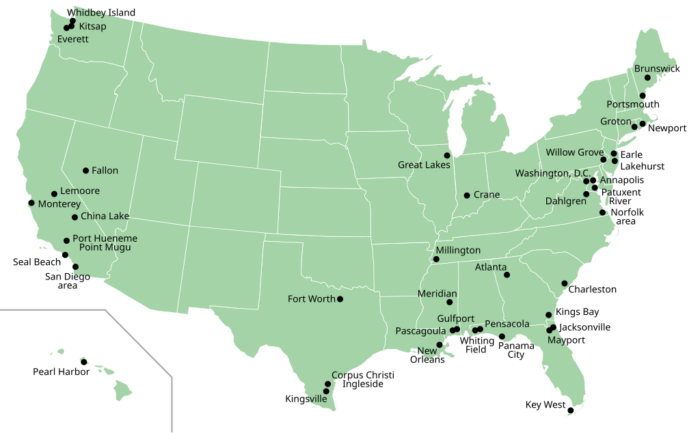
Map of naval bases in the United States
In redaction
USCG today
In redaction
Current Carrier Strike Groups
In redaction
Carrier Strike Group One: USS Carl Vinson (CVN-70) CAW2, DESRON-1, NS San Diego, California
Carrier Strike Group Two: USS Dwight D. Eisenhower (CVN-69), CAW 3, DESRON-22 NS Norfolk, Virginia
Carrier Strike Group Three: USS Abraham Lincoln (CVN-72) CAW 9, DESRON-21, NS San Diego, California
Carrier Strike Group Five: USS George Washington (CVN-73), CAW 5, DESRON-15 FAB Yokosuka, Japan
Carrier Strike Group Eight: USS Harry S. Truman (CVN-75) CAW 1, DESRON-28 NS Norfolk, Virginia
Carrier Strike Group Nine: USS Theodore Roosevelt (CVN-71) CAW 11, DESRON-9, NS San Diego, California
Carrier Strike Group Ten: USS George H. W. Bush (CVN-77) CAW 7, DESRON-26, NS Norfolk, Virginia
Carrier Strike Group Eleven: USS Nimitz (CVN-68) CAW 17, DESRON-23 NS Everett, Washington
Carrier Strike Group Twelve: USS Gerald R. Ford (CVN-78) CAW 8, DESRON-2 NS Norfolk, Virginia
Current USN Aviation
In redaction
List
Carrier Planes
F/A-18E/F Super Hornet: 421 (76 on order)
F-35C Lightning II: F-35C: 30 (16+188 on order)
E-2C/D Hawkeye: 97 (27 on order)
EP-3E ARIES II: 12.
E-6B Mercury: 16
EA-18 Growler (EA-18G): 152
Patrol Planes
P-3C Orion: 28, to be replaced by the P-8 Poseidon.
P-8A Poseidon (P-8A): 112 (18 on order)
Others
Tanker KC-130T Hercules: 10
Carrier Transport C-2A Greyhound (to be replaced with V-22 Osprey)
UC-12 Huron: 13
C-20G Grey Ghost: 3
C-26D Metroliner: 8
C-38A Courier: 2
C-40A Clipper: 17
C-130T Hercules: 17
C-130J Super Hercules: 1
V-22 Osprey (CMV-22B): 12 (49 on order).
Helicopters
MH-53E Sea Dragon: 29
HH-60H Rescue Hawk: 8
MH-60RMH-60S Seahawk: 561
SH-60BSH-60F Seahawk: 189
Trainers
TH-57BTH-57C Sea Ranger: 115
UH-72A Lakota: 5
TH-73A Thrasher: 128 on order
U-1B Otter: 1 +U-6A Beaver: 2
F-5FF-5N Tiger II (Top Gun Adversary trainer): 31
F-16AF-16B Fighting Falcon (Top Gun Adversary trainer): 14
F/A-18A/B/C/D/E/F Hornet Trainer: 183, reserve, “non-deployable”*.
T-6AT-6BT-6C Texan II: 293 (29 on order)
T-34C Mentor: 13
T-38A Talon: 10
T-44A Pegasus: 56
T-45C Goshawk: 191
*While the F/A-18C is possessed by the Navy Reserve Strike fighter squadron VFA-204, due to their unsuitability in combat situations in regards to their lack of modern avionics, communications equipment and weapons integration, they are used solely as an adversary/aggressor trainer.
UAVs
MQ-4C Triton (Surveillance & patrol: 30
MQ-8AMQ-8B Fire Scout (helicopter) MQ-8: 30
MQ-8C Fire Scout (helicopter): 19
Boeing MQ-25 Stingray (Aerial refueling): 1 (72 planned)
USN New Weapon Systems
Current U.S. Navy shipboard weapons systems are almost entirely focused on missiles, both as a weapon and as a threat. In an offensive role, missiles are intended to strike targets at long distances with accuracy and precision. Because they are unmanned weapons, missiles allow for attacks on heavily defended targets without risk to human pilots. Land strikes are the domain of the BGM-109 Tomahawk, which was first deployed in the 1980s and is continually being updated to increase its capabilities. For anti-ship strikes, the navy’s dedicated missile is the Harpoon Missile. To defend against enemy missile attack, the navy operates a number of systems that are all coordinated by the Aegis combat system.
Medium-long range defense is provided by the Standard Missile 2, which has been deployed since the 1980s. The Standard missile doubles as the primary shipboard anti-aircraft weapon and is undergoing development for use in theater ballistic missile defense. Short range defense against missiles is provided by the Phalanx CIWS and the more recently developed RIM-162 Evolved Sea Sparrow Missile. In addition to missiles, the navy employs Mark 46, Mark 48, and Mark 50 torpedoes and various types of naval mines.
Naval fixed-wing aircraft employ much of the same weapons as the United States Air Force for both air-to-air and air-to-surface combat. Air engagements are handled by the heat-seeking Sidewinder and the radar guided AMRAAM missiles along with the M61 Vulcan cannon for close range dogfighting. For surface strikes, navy aircraft use a combination of missiles, smart bombs, and dumb bombs. On the list of available missiles are the Maverick, SLAM-ER and JSOW. Smart bombs include the GPS-guided JDAM and the laser-guided Paveway series. Unguided munitions such as dumb bombs and cluster bombs make up the rest of the weapons deployed by fixed-wing aircraft.
Rotary aircraft weapons are focused on anti-submarine warfare (ASW) and light to medium surface engagements. To combat submarines, helicopters use Mark 46 and Mark 50 torpedoes. Against small watercraft, they use Hellfire and Penguin air to surface missiles. Helicopters also employ various types of mounted anti-personnel machine guns, including the M60, M240, GAU-16/A, and GAU-17/A.
Nuclear weapons in the U.S. Navy arsenal are deployed through ballistic missile submarines and aircraft. The Ohio-class submarine carries the latest iteration of the Trident missile, a three-stage, submarine-launched ballistic missile (SLBM) with MIRV capability; the current Trident II (D5) version is expected to be in service past 2020.[103] The navy’s other nuclear weapon is the air-deployed B61 nuclear bomb. The B61 is a thermonuclear device that can be dropped by strike aircraft such as the F/A-18 Hornet and Super Hornet at high speed from a large range of altitudes. It can be released through free-fall or parachute and can be set to detonate in the air or on the ground. –>
Equipments
As of 2018, the navy operates over 460 ships (including vessels operated by the Military Sealift Command), 3,650+ aircraft, 50,000 non-combat vehicles and owns 75,200 buildings on 3,300,000 acres (13,000 km2). However other sources goes for 380. This depends of classifications, such as including submarines as “ships” or not as well as those in reserve, and still listed, and possibly auxiliaries.
Naming conventions 101
The names of commissioned ships in the U.S. Navy are prefixed traditionally by “USS”, standing for “United States Ship”. Non-commissioned or civilian-manned vessels are prefixed “USNS” for “United States Naval Ship”. Names are officially selected by the secretary of the navy as vote for funding new ships goes through the Congress and therefore had political significance. Names are thus often those of important people or places. Importantly the classification comprised a letter-based hull symbol, CVN, DDG, FFG, SSN, SSBN, ect. indicating type and serie number. This practice was only adopted in the cold war. All are listed in the Naval Vessel Register, or “Navy List” which existed in other navies traditionally since centuries, and this is required by article 29 of the UN Convention on the Law of the Sea of all nations to keep records transparents. Now numeri and accessible from anyweere, this register keeps the date of commissioning, decommissioning and removal from the register prior to disposal means “stricken from the register” also keeping an old tradition of ships listed indeed sticken by a pen stroke on the page. The navy maintains a reserve fleet, maintained for reactivation in crisis as well and manned by reservists. The maintenance of these ships is a constant source of debates as costs are associated, though far less in comparison of active ships.
The USN was a pioneer in nuclear propulsion and had great plans in 1960 for an all-nuclear carrier battle group, but it proved at the same time too costly and optimistic. As of today it’s only kept for aircraft carriers and submarines.
The 2010 white paper expressed the need for 313 combat ships but funds only authorized to maintain 232 to 243. In March 2014 minesweepers, surveillance craft, or tugs were included to inflat the “battle fleet” and preent a more reassuring 272 by October 2016 but it was quite stretch. By counting every floating vessel or any description numbers copuld go indeed from 270 to 460 in 2019. By February 2022 this was 296 “battle force” ships, far from what would be needed to meet the USN actual commitments, 500 ships. Again, drones could be an interesting alternative to met this, at a greater initial cost (R&D) but long terms lower costs, without direct personal assigned and everything associated. Just like for the Air Force drones used in combat for decades, it’s likely these new USVs (surface), UUVs (underwater) and UAVs (airborne) would greatly lower maintenance costs, provided the technology is well mastered and standardization plays its part. This is the best guest to reach a potential 500 ship fleet at the horizon 2030+.
US Aircraft Carriers

USS Nimitz and USS Port Royal off Japan in 1997
Aircraft carriers in the USN today plays a larger role than in WW2. They are still airbases for carrier-based aircraft, largest vessels in the fleet and nuclear-powered to greatly enhance their continuous operation, less the crews. In addition to a role that clearly waned off after the endonf the cold war, sea surface combat on a peer naval force, or even ASW tasks, the new sets of role found for these are concentrated on local support operation, strikes in depth, and area control. Plus also since WW2 the concept of dedicated escort hhad more than half a century to evolve and mature. Today an aircraft carrier is deployed along with many additional vessels which together forms the carrier strike group (former Carrier Battle Group or CBG).
Supporting ships include always 3-4 Aegis-equipped cruisers and/or destroyers, an ASW frigate, two attack submarines to the carrier from all threats and add by themselves extra strike capabilities. There is also, and this is new compared to WW2, an organic logistics support for ammunition, oil and supply, often a single dedicated ship. Modern US carriers since USS Nimitz maintains a tradition of American admirals and now politicians, mostly presidents. The current statutory requirement is of 11 aircraft carriers, all currently active, for a near-match with registered CSGs. Each carrier is a floating airbase with 5,000 persobnal including the air group personal and the on board power to match. Since the US Midway and even prior to that with the 1936 idea of a “sunday punch” of 100-strong air wing strike, these Nimitz class (and G. Ford Class) are set to operate a respectable 90 aircraft at one time. No aircraft carrier outside the US had this capacity. This air group is a force multiplier, capable of a large variety of missions and extends the protective bubble of the CSG over hundreds of miles.
 Gerald R. Ford class (2013)
Gerald R. Ford class (2013)
USS Gerald R. Ford, John F. Kennedy*, Enterprise*, Doris Miller*, William J. Clinton*, George W. Bush* +4
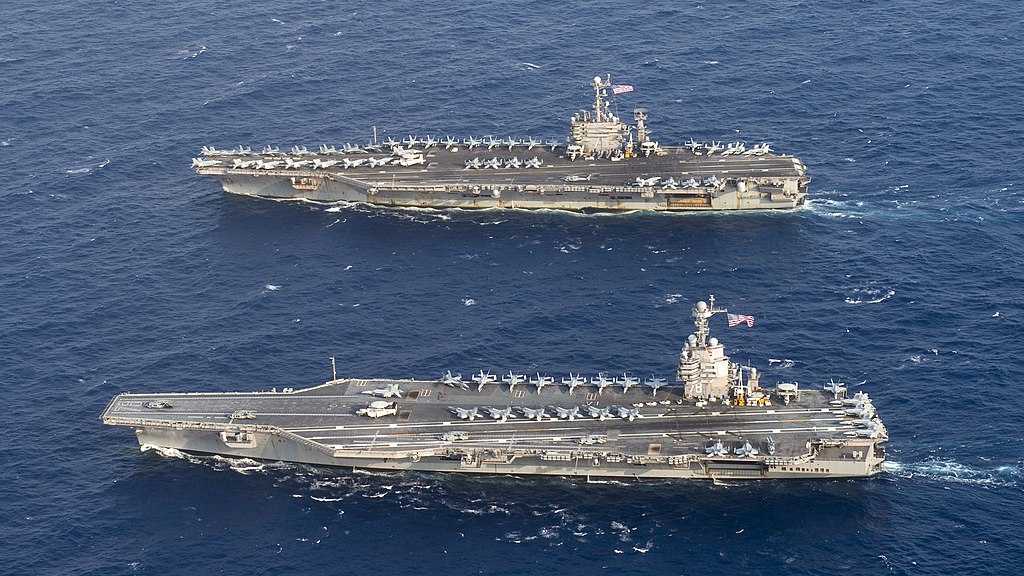
The Gerald R. Ford-class nuclear-powered aircraft carriers are the designated replmacvement for the Nimitz class supercarriers, in service since 50 years. The United States Navy plans to replace all 10 Nimitz class eventually with a one-for-one basis, starting with the lead ship USS Gerald R. Ford (CVN-78), replacing the older and famous USS Enterprise (CVN-65). The hull is similar to the Nimitz class, with the new tech of the CVN(X)/CVN-21 program, the deck space is greater, the island smaller and relocated further aft, and Electromagnetic Aircraft Launch System (EMALS) replaced steam catapults. They are countrless other design features to improve efficiency and reduce operating costs, notably automation, to run with smaller crews and even adaptations to use UCAVs. Ford was commissioned in July 2017 and USS John F. Kennedy (CVN-79), replacing a Kitty Hawk class carrier now long retired, is scheduled to enter service this year in 2025. Other names are already known for those in constrution like USS Enteprise(iii), while Miller, Clinton and Bush already are planned by not laid down. The adoption of “Doris Miller” contrasts to the usual presidential names, but was a recoignision of diversity in the USN, also honoring a simple sailor, and WW2 war hero. USS Enteprise is also an exception, but the name is just too important to ignore. CV-6 and CV-65 both had legendary careers. CV-6 as the most decorated of WW2, CV-65 as the world’s first nuclear powered and also decorated veteran of the cold war, from Vietnam to the gulf war.
 Nimitz class (1972)
Nimitz class (1972)
USS Nimitz, Dwight D. Eisenhower, Carl Vinson, Theodore Roosevelt, Abraham Lincoln, George Washington, John C. Stennis, Harry S. Truman, Ronald Reagan, George H.W. Bush (CVN-77)

The Ninitz-class nuclear-powered fleet carriers really constituted the backbone of US Navy for the last decades of the cold war. In 1990 when USSR fell, ending the cold war (as most thought) the USN had five, one for each major fleet: USS Nimitz, Dwight D Eisenhower, Carl Vinson, Theodore Roosevelt, and Abraham Lincoln. Three more were under construction, five more would be built total until a new design change brought the Ford class. Ten aircraft carriers built over 41 years, whereas only 16 years separated the Nimitz from the Forrestals. That’s how much trust went into the design. There was a lot of debate in the 2000s over a successor, notably because of some critics.
Cruisers
Cruisers are a distinctive feature of the USN as the premium naval power, as the type is considered too costly to operate by everybody else but the Soviet Union. The term is now contested, if not obsolete since guided missile destroyers had long caught up. What made these large surface combat vessels unique in the cold war was their nuclear propulsion for a full CBG protection, anti-air/anti-missile warfare, surface warfare, anti-submarine warfare, or strike operations independently if needed. A shift was done through budget reduciton, creating the last cruiser class (Ticonderoga) as a development of the Spruance class ASW destroyers, sharing the same hull, but only earning the title thanks to their AEGIS combat system with the AN/SPY-1 phased array radar and RIM-67 Standard at its core. But if the Ticonderoga-class were the first to be so equipped and are still very capable in offensive and defensive battle operations, the new Arleigh Burke class destroyers also came up with AEGIS making them redundant. That way, they are now gradually retired from service.
 Ticonderoga class (1981)
Ticonderoga class (1981)
USS Philippine Sea, Princeton, Normandy, Robert Smalls, Gettysburg, Chosin, Shiloh, Lake Erie, Cape St. George
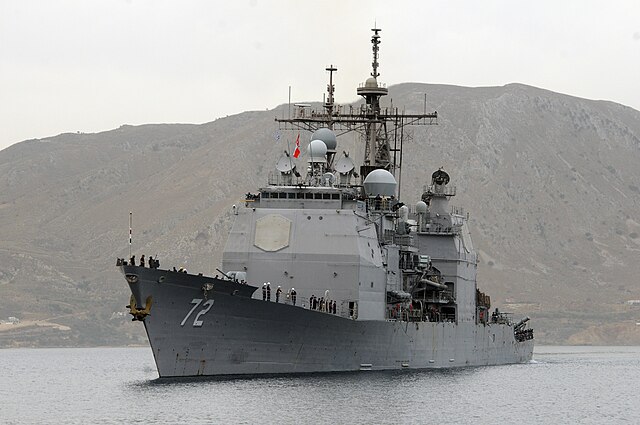
These missile destroyers, eventually renamed missile cruisers, were derived from the previous Spruance class, but fully designed to implement the new AEGIS system, a true revoluton in detection, command, target management, fire control and weapons/ECM management response. In fact, they were (are still) known as the “Aegis cruisers”. The latter system was originally designed for an anti-aircraft escort frigate, like the future California cruisers. Their design was the result of numerous studies and landmarks from the late 1970s, which resulted in the rejection of Typhon frigate project and heavy cruisers of the CSGN type. Instead, the backup destoryer solution based on the largest destroyer hulls of the time, Spruance, was preferred. Today, only a fraction of the class remains operational, all named after battles. The ones mothballed are not scrapped yet. Proposed inactivations were pushed up to 2027 for the last ships, USS Chosin (CG-65) and Cape St. George (CG-71). For now there is no replacement project firmly planned, only prospects. They might be the last ones of the “CG” line.
 CG(X)
CG(X)
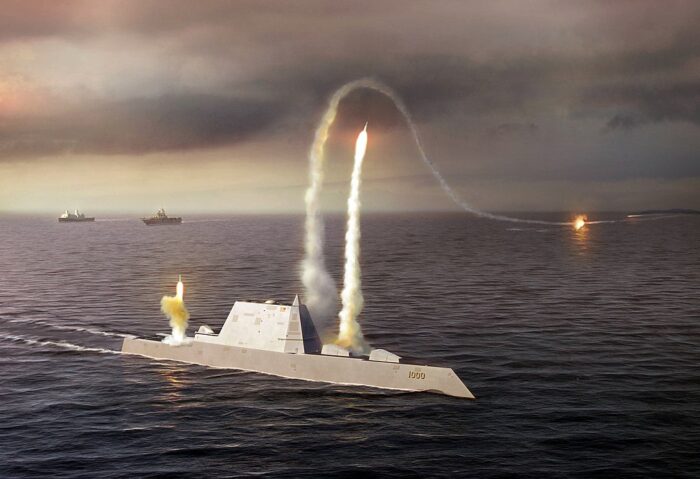
CG(X) was the planned next-generation cruiser program for the U.S. Navy, intended to replace the Ticonderoga-class cruisers. It was meant to be a heavily armed warship with advanced air and missile defense capabilities, but the program was canceled in 2010 due to budget constraints and shifting priorities. It was replaced by the Flight III Burke class, which serie was pushed from 90 to 99 planned.
Destroyers
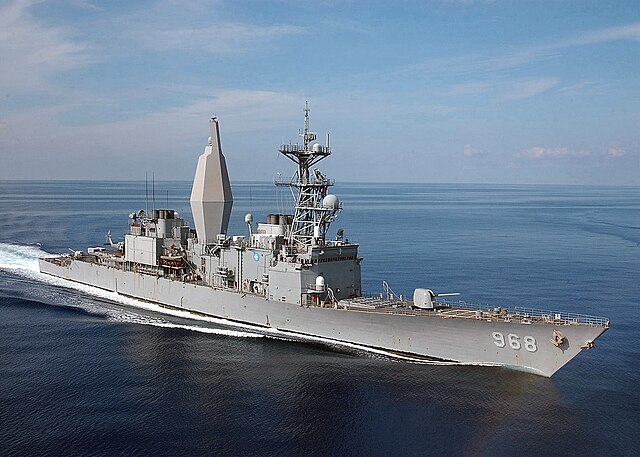
At sea aboard USS George Washington (CVN 73) Nov. 27, 2002. The USS Arthur W. Radford (DD 968), a Spruance-class destroyer, steams in the Mediterranean Sea. The Radford is part of the George Washington Battle Group on a scheduled six-month deployment. (U. S. Navy photo by Photographer’s Mate Third Class Summer M. Anderson). Testing new Advanced Enclosed Mast/Sensor System to benefit the fuuture batches of the Burke class, as seen here, she was the last discarded of the legacy 1970s Spruance class in 2011.
Modern USN Guided Missile Destroyers are from a single class, the Arleigh Burke. The last Spruance class ships, planned in the 1960s as specialized ASW destroyers to hunt down the latest Soviet subs, were rearmed and upgraded as fully-fledged multirole ones over the years, but started to be decommissioned in 2001 up to 2009. The last, USS Arthur W. Radford (DD-968) was gone in 2011. They are known replaced by an ongoing serie of the multi-mission medium surface ships of the Arleigh Burke class, in anti-air, anti-submarine, anti-ship, and offensive strike operations. They are the bedrock of the assets deployed with a carrier strike group or expeditionary strike group, and are equipped with the latest variants of the Aegis system, but tailored for their multiple tasks, whereas AEGIS-equipped cruisers of the Ticongeroga class are primarily tasked with defending the fleet against AA threats. The current Burke class by production is the largest in US inventory since WW2. They are named after U.S. Navy, Marine Corps, and Coast Guard heroes. With 73 Arleigh Burke-class and more to enter service for a total of 99 ships planned (more than the WW2 Sumner class and even Gearing class when all would be completed FY), they are also infinitely more capable.
 Arleigh Burke class (1990)
Arleigh Burke class (1990)
73 in service, 90 planned
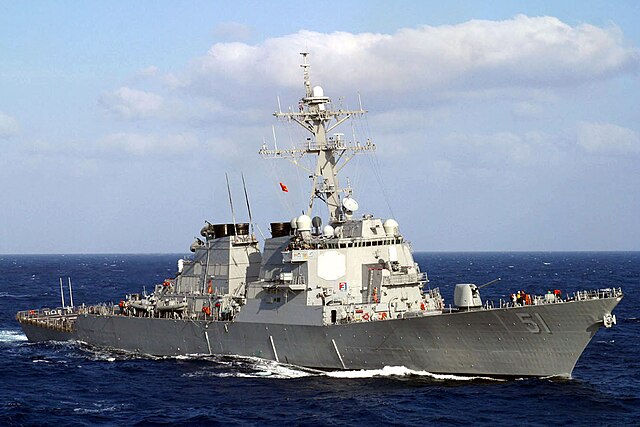
What else to close this year than the current Arleigh Burke class destroyers. Designed in the early 1980s they were a product of the cold war, designed to marry AEGIS capabilities of a Ticonderoga class cruiser with more rounded capabilities than the 1970s Spruance class ASW destroyers. It was hope to weave this into a single and more versatile package, but still the “low-end” ships types wanted by Zumwalt. In 1984 it was still hoped each would cost about 2/3 as much as a Ticonderoga, while offering 3/4 of her AA potential… These 70+ destroyers built in successive batches, modernized a lot over the past 35 years, are still built today and for the foreseeable future, as the backbone of the USN with a planned 90 ship total fleet. They are prepared today still for the though Challenges to come, notably in Asia.
The class comprises today the USS Arleigh Burke, Barry, John Paul Jones, Curtis Wilbur, Stout, John S. McCain, Mitscher, Laboon, Russell, Paul Hamilton, Ramage, Fitzgerald, Stethem, Carney, Benfold, Gonzalez, Cole, The Sullivans, Milius, Hopper, Ross, Mahan, Decatur, McFaul, Donald Cook, Higgins, O’Kane, Porter, Oscar Austin, Roosevelt, Winston S. Churchill, Lassen, Howard, Bulkeley, McCampbell, Shoup, Mason, Preble, Mustin, Chafee, Pinckney, Momsen, Chung-Hoon, Nitze, James E. Williams, Bainbridge, Halsey, Forrest Sherman, Farragut, Kidd, Gridley, Sampson, Truxtun, Sterett, Dewey, Stockdale, Gravely, Wayne E. Meyer, Jason Dunham, William P. Lawrence, Spruance, Michael Murphy, John Finn, Ralph Johnson, Rafael Peralta, Thomas Hudner, Paul Ignatius, Daniel Inouye, Delbert D. Black, Carl M. Levin, Frank E. Petersen Jr., John Basilone, Lenah Sutcliffe Higbee, Jack H. Lucas.
 Zumwalt class DDs (2013)
Zumwalt class DDs (2013)
Zumwalt, Michael Monsoor, Lyndon B. Johnson
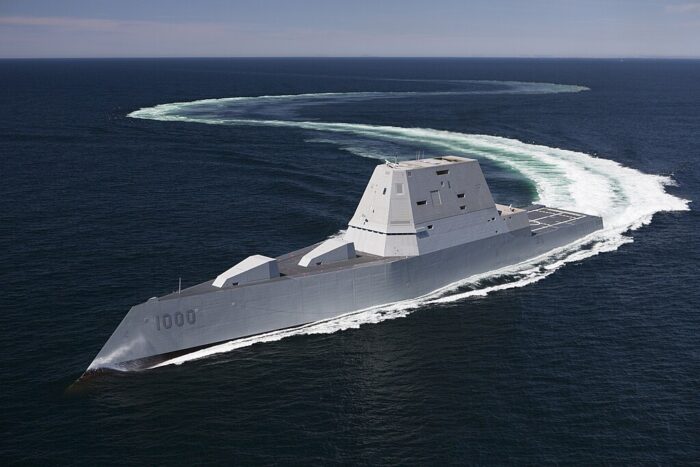
What else to close this year than the current Arleigh Burke class destroyers. Designed in the early 1980s they were a product of the cold war, designed to marry AEGIS capabilities of a Ticonderoga class cruiser with more rounded capabilities than the 1970s Spruance class ASW destroyers. It was hope to weave this into a single and more versatile package, but still the “low-end” ships types wanted by Zumwalt. In 1984 it was still hoped each would cost about 2/3 as much as a Ticonderoga, while offering 3/4 of her AA potential… These 70+ destroyers built in successive batches, modernized a lot over the past 35 years, are still built today and for the foreseeable future, as the backbone of the USN with a planned 90 ship total fleet. They are prepared today still for the though Challenges to come, notably in Asia. But the announcement as a complement frigate, the constellation class is expected to share bit of their current burden, provided they are built at all… In the meantime, the Burke class remains the naval bulwark of the free world.
 DDG(X)
DDG(X)
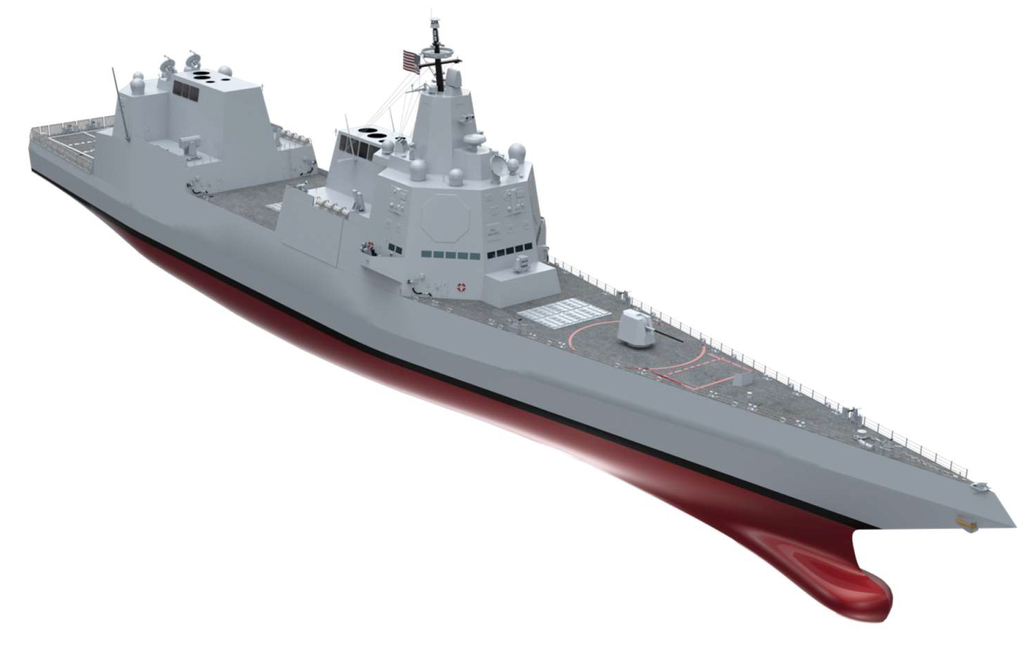
The DDG(X) program is the U.S. Navy’s next-generation guided-missile destroyer program, intended to replace the Arleigh Burke-class (DDG-51) destroyers starting in the 2030s. It aims to provide enhanced lethality, survivability, and energy efficiency while incorporating advanced technologies. Larger Hull & Increased Range compared to the Arleigh Burke-class for better endurance and space for future upgrades and increased fuel efficiency to support longer missions. Fitted with the Integrated Power System (IPS) like the Zumwalt-class (DDG-1000), allowing power to be distributed efficiently across weapons and propulsion. Supports also energy-intensive weapons like lasers and railguns. SPY-6 Air and Missile Defense Radar (AMDR) for better detection and tracking, Improved Aegis Combat System integration, More Vertical Launch System (VLS) cells than current destroyers. Designed to accommodate lasers (potentially 150 kW+ for anti-missile and anti-drone defense). Ability to carry hypersonic weapons (Conventional Prompt Strike missile). Incorporates lessons from the Zumwalt-class for reduced radar signature. Better damage control and survivability features. Timeline: 2022: initial design work began, 2028 Planned construction start, early 2030s First expected to enter service.
The DDG(X) isd meant to replace the Arleigh Burke-class, reaching its design limits and the Navy needs larger, more powerful destroyers to handle future threats, including China and Russia’s evolving missile technology. The Zumwalt-class (DDG-1000) was too expensive for mass production, so DDG(X) will balance cost and capability. As of today in 2025, the DDG(X) program to replace the Burke class is planned FY2032. At the time, more Burke class Flight III should still enter sevrice.
Initially, the buried CG(X) program was replaced by the “Future Surface Combatant” (FSC) to replace both the Ticonderoga-class and Flight I batch of the Burke class, FY 2035-40. Then it became the Large Surface Combatant (LSC) program, and ended as the DDG(X) which program office was established in June 2021. By February 2022, Gibbs & Cox was contracted for design and engineering support. The famous NY based naval architecture studio designed all interwar and WW2 US destroyers and the famous liner USS United States, recently announced to be sunk as artificial reef.
Frigates
Modern U.S. frigates are still specialized in anti-submarine warfare, add-on assets to any carrier and expeditionary strike groups. They could also act as escorts for supply convoys and merchant shipping, freeing destroyers for more urgent tasks. They are the inheritors of the WW2 mass-produced destroyer escort class and new ships were created in the cold war for a gradual replacement of this legacy fleet, alongside many reconverted FRAM-I/II destroyers. The ASW frigate concept in the cold war reach its zenith with the mass-produced Knox and OH perry classes.
Like destroyers, frigates are named after U.S. Navy, Marine Corps, and Coast Guard heroes, but they were massively affected by post-cold war budget cuts. By late 2015, the U.S. Navy retired its last traditional OH Perry class frigates in favor of the littoral combat ship (LCS), a cobcept reflecting the new asymetric warfare concepts of the day. But the LCS wazs marred by many issues, and are now seen, with the new challenges in Asia facing the Chinese, as underarmed and short-ranges. This led to retire many LCS well below service standards, to focus on a return of high intensity warfare frigates, with up to 20 of the Constellation-class frigate drived from the European FREMM 7000 tonnes multipurpose “heavy frigate” design. This left the USN currently as for frigate rank vessels, with 23 littoral combat ships, 8 Freedom-class, 15 Independence-class.
 Constellation class (2025)
Constellation class (2025)
USS Constellation (FFG-62), USS Congress (FFG-63), USS Chesapeake (FFG-64)
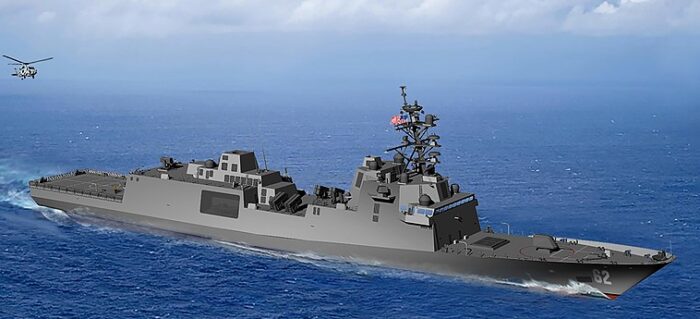
The Constellation-class frigates (FFG-62) are the U.S. Navy’s next-generation multi-mission guided-missile frigates, designed to provide air defense, anti-submarine warfare (ASW), and surface warfare (SUW) capabilities. They will serve as a more affordable and efficient complement to the Arleigh Burke-class destroyers (DDG-51). They are Based on a Proven European Design, Adapted from Fincantieri’s FREMM (European Multi-Mission Frigate), used by Italy and France and modified for U.S. Navy requirements, including Aegis combat system integration. It is planned for the AN/SPY-6(V)3 radar (a scaled-down version of the DDG-51 Flight III radar) with an Aegis Baseline 10 Combat System for improved missile defense and AN/SQS-62 Variable Depth Sonar (VDS) and towed array sonar for anti-submarine warfare.
They are planned to have 32 Mk 41 Vertical Launch System (VLS) cells for SM-2, ESSM, and potentially Tomahawk or SM-6 missiles, Naval Strike Missile (NSM) launchers for anti-ship warfare, the Mk 110 57mm gun for surface threats, Mk 49 Rolling Airframe Missile (RAM) system for close-in air defense and two MH-60R Seahawk helicopters + UAVs for ASW and reconnaissance.
The are designed for Low radar cross-section design and having a better survivability than littoral combat ships (LCS), with enhanced armor and damage control.
They are powered by a Combined Diesel-Electric and Gas (CODLAG) propulsion system for fuel efficiency for over 7,000 nautical miles range at 16 knots.
Timeline: 2020 – Fincantieri Marinette Marine (Wisconsin) won the contract, 2022 Keel laid for USS Constellation, 2026-2027, 2030s at least 20 ships planned.
The Constellation-Class fills the capability gap between destroyers and littoral combat ships (LCS), more survivable and heavily armed than the LCS and designed for fleet escort, sea control, and expeditionary operations in contested environments, helping to counter Chinese and Russian naval expansion in the Indo-Pacific and elsewhere.
 Freedom class (2008)
Freedom class (2008)
USS Fort Worth, Wichita, Billings, Indianapolis, St. Louis, Minneapolis-Saint Paul, Cooperstown, Marinette, Nantucket, Beloit (LCS-29)
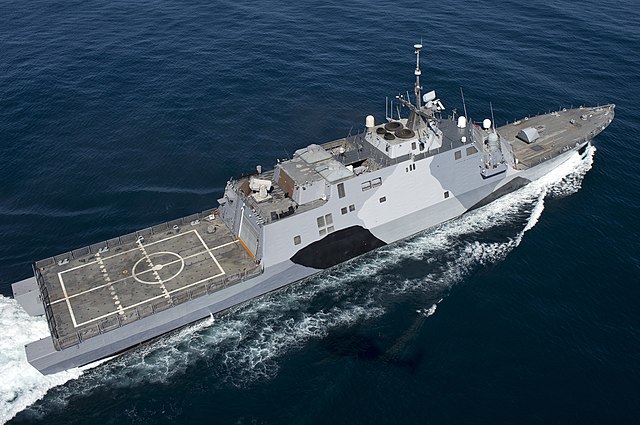
The Freedom-class littoral combat ships (LCS) are fast, modular, multi-mission warships designed for coastal (littoral) operations, built for the U.S. Navy as part of the Littoral Combat Ship (LCS) program along with the Independence-class. Primary Role: Littoral (coastal) operations, anti-submarine warfare (ASW), surface warfare (SUW), mine countermeasures (MCM). They were built by Lockheed Martin & Marinette Marine (Wisconsin, USA), 16 ships built, some retired early due to maintenance issues. Some ships are in service, others being decommissioned early due to reliability concerns.
They are a High-speed design with a top speed of 40+ knots (46 mph) and a Waterjet propulsion instead of propellers, allowing high-speed turns and shallow-water operations. They have a Modular Mission Packages, Swappable for different role.
ASUW: 57mm gun, Hellfire missiles, .50 caliber guns, and helicopters.
ASW: Variable-depth sonar, towed array sonar, and MH-60R helicopter.
MCM: Unmanned underwater vehicles (UUVs) for mine detection and neutralization.
Mk 110 57mm gun (capable of engaging air, surface, and land targets).
Rolling Airframe Missile (RAM) system for air defense.
Naval Strike Missile (NSM) compatibility (recent upgrades for more firepower).
Helicopter Hangar for MH-60R Seahawk + MQ-8 Fire Scout UAVs.
AN/SQR-20 Multi-Function Towed Array Sonar (MFTA) (for ASW variants).
Smaller crew size (~75) due to high automation and stealthier design compared to larger destroyers.
Problems & Criticism:
-Engine & Reliability Issues – Gearbox failures led to early decommissioning of some ships.
-Limited Firepower & Survivability – Not suited for high-intensity naval combat.
-Modular Mission Packages Flaws – Some systems (like MCM) faced long delays.
-High Costs & Limited Capability – Expensive to maintain compared to destroyers and frigates.
-Decommissioning & Replacement due to performance issues, several Freedom-class LCS ships are being retired early.
The Constellation-class frigates (FFG-62) are seen as a more capable replacement for some of the LCS roles.
Some LCS ships are being repurposed for South American and Pacific missions, focusing on counter-narcotics and patrol duties.
 Independence class ()
Independence class ()
USS Jackson, Montgomery, Gabrielle Giffords, Omaha, Manchester, Tulsa, Charleston, Cincinnati, Kansas City, Oakland, Mobile, Savannah, Canberra, Santa Barbara, Augusta, Kingsville
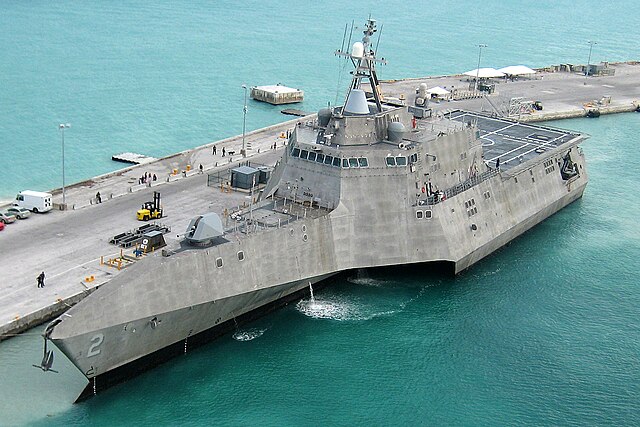
The Independence-Class LCS were tasked of Coastal patrol, anti-submarine warfare (ASW), surface warfare (SUW), mine countermeasures (MCM) and built at Austal USA (Alabama, USA), 19 built, but some decommissioned early, with some in service, others being retired early due to high maintenance costs and evolving mission needs. They had an Unique Trimaran Hull Design, with an Aluminum trimaran hull (unlike the steel monohull of the Freedom-class), Greater stability and deck space for aircraft, drones, and mission modules, Better fuel efficiency and endurance compared to the Freedom-class.
It had Modular Mission Packages swappable for different roles.
From Surface Warfare (SUW): 57mm gun, Hellfire missiles, and UAVs.
Anti-Submarine Warfare (ASW): Towed array sonar, ASW helicopters.
Mine Countermeasures (MCM): Unmanned underwater vehicles (UUVs) for mine hunting.
The hull enabled a top speed of 44+ knots (50+ mph), and had a shallow draft allows operations in coastal and island waters.
Armament: Mk 110 57mm gun, for surface threats, RAM system, Naval Strike Missile (NSM) for anti-ship warfare, MH-60R Seahawk helicopter and MQ-8 Fire Scout drones as well as Advanced radar & electronic warfare systems.
It had a smaller crew with 75 sailors due to automation and more space for mission modules & aircraft.
It had an Aluminum Hull Issues with early versions suffering from structural cracks and corrosion problems.
It had limited Firepower is not suited for high-end naval combat against major threats, high Maintenance Costs. There were Mission Module Delays notably for the mine countermeasure (MCM) package with reduced effectiveness. LCS ships are being used for South American and Pacific patrols, focusing on drug interdiction and maritime security.
Amphibious Force
Inherintiong the Pacific fleet experience of WW2, the USN still maintains a modern and powerful (the world’s largest) Amphibious fleet today. Its core are multirole, aircraft and helicopter carrying assault ships as centerpieces, capable of carrying themselves in internal docks hovercrafts and classis LCU/LCIs for landing operations, airborne landings and full airborne support on site. They incarnate the same projection role as aircraft carriers but focusing on land forces instead of just air power. These ships as part of the typical ESG (Expeditionary Strike Group) are tasked to command, coordinate, and fully support a 2,200-strong Marine Expeditionary Unit. Like reduced aircraft carriers, modern LHDs combined V/STOL, STOVL, VTOL, tiltrotor, and rotary wing assets for a large range of shore operations. As motherships, their best assets for a first line assault are the fast Landing Craft Air Cushion (LCAC) as well as vehicles such as the AA7V and its planned sucessor. ESGs are protected by the same multi-layered defense procured to CSGs: Aegis-equipped cruiser and destroyer, frigate, and attack submarine. They also counts in addition to large LHDs, additional amphibious transport dock and dock landing ship for second wave amphibious assault (exploitation). By their size, they these LHDs are named after World War II aircraft carriers.
However the concept changed in time. Instead of costly carrier- like LHDs, the new San Antonio class are more centered to operate all three elements of the Marines or “mobility triad” with Expeditionary Fighting Vehicles (EFVs), V-22 Osprey tiltrotor aircraft and LCACs on a cheaper and smaller package with hybrid deck, and a tradition of names after U.S. cities. Existing dock landing ship as medium amphibious transport operaties as a secondary launch platform for LCACs.
The US Navy today operates 32 amphibious warfare ships: 8 Wasp class, 2 America class LHDs (more to come), 4 Harpers Ferry class, 6 Whidbey Island class LSDs (dock landing ships), 12 San Antonio class amphibious transport docks. If mustered together, they could land the entire USMC expeditionary arm, division size.
 America class (2008)
America class (2008)
USS America, USS Tripoli, +9 in construction or planned
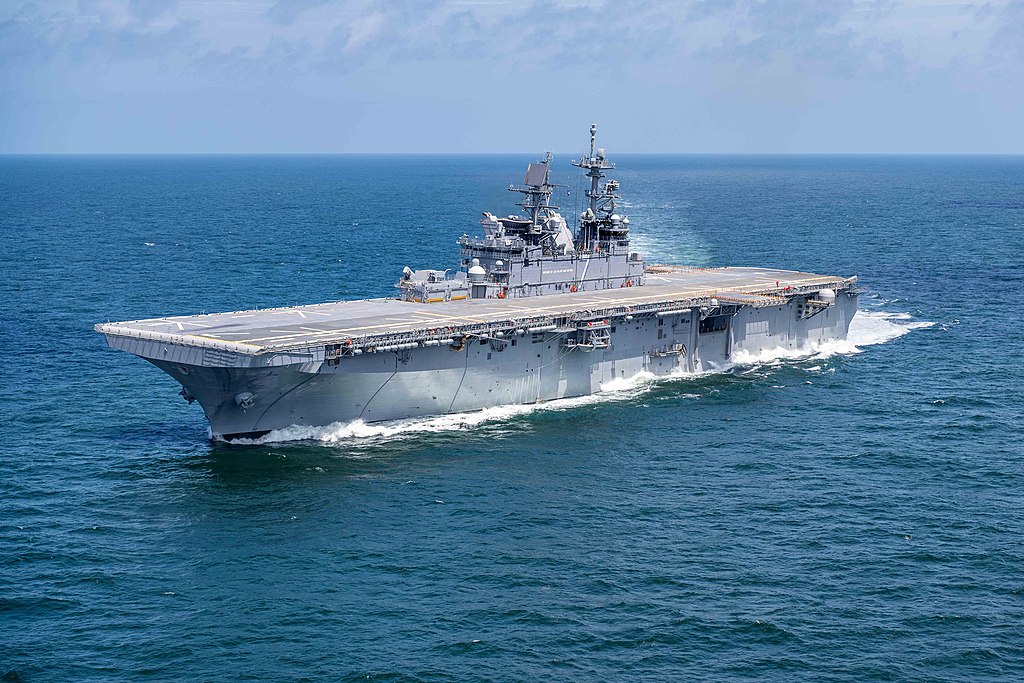
The America-class amphibious assault ships are a class of landing helicopter assault (LHA) vessels designed for the United States Navy. These ships serve as small aircraft carriers, supporting a wide range of missions, including amphibious warfare, power projection, and humanitarian assistance.
Key Features: Displacement: ~45,000 tons full load for ~844 feet (257 meters) long.
Speed: Over 22 knots (41 km/h), 1,200 sailors + 1,800 Marines. Capacity: Helicopters, tiltrotors (MV-22 Osprey), and F-35B Lightning II fighters. Well Deck (LHA 8 and later) for landing craft and amphibious vehicles.
USS America (LHA-6) was commissioned in 2014, Tripoli (LHA-7) was Commissioned in 2020, USS Bougainville (LHA-8) is Under construction (Expected delivery ~2026) and LHA-9 (Unnamed) is Under contract.
They acts as a “Lightning Carrier”, Can operate up to 20+ F-35B stealth fighters, similar to a small aircraft carrier
They Supports amphibious operations – Deploys Marines via MV-22 Ospreys, CH-53K King Stallions, and amphibious vehicles
They Lacks a Well Deck (LHA-6 & LHA-7) – Focuses on air operations but later ships (LHA-8 and onward) bring back well decks for landing craft
These are designed to replace the Tarawa-class and complement the Wasp-class amphibious assault ships. With their ability to operate F-35B jets and advanced rotorcraft, they significantly enhance USMC and USN expeditionary capabilities.
 Wasp class LHD (1987)
Wasp class LHD (1987)
USS Wasp, Essex, Kearsarge, Boxer, Bataan, Iwo Jima, Makin Island
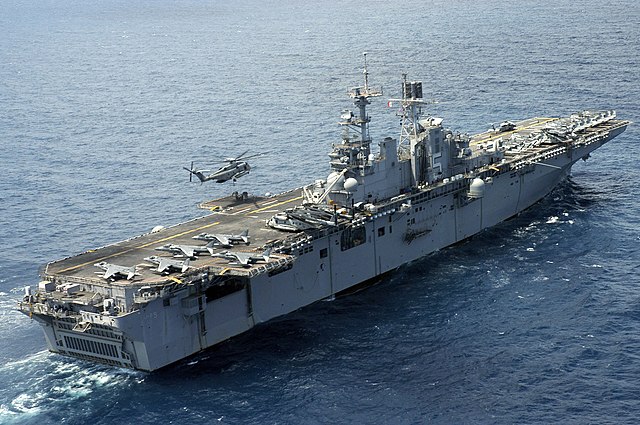
The Wasp-class (LHD) amphibious assault ships are landing helicopter dock (LHD) vessels used by the United States Navy to support Marine Corps expeditionary operations. These ships function as mini aircraft carriers, capable of deploying a variety of aircraft, landing craft, and amphibious vehicles.
Specs:
Displacement: ~41,000 tons full load, 843 feet (257 meters) long.
Speed: 22+ knots (41 km/h), crew ~1,200 sailors + ~1,900 Marines
Well Deck with LCACs, AAVs), air grpup with MV-22 Ospreys, CH-53K King Stallions, AH-1Z Vipers, UH-1Y Venoms, F-35B Lightning II, and AV-8B Harriers
Only LHD-6 USS Bonhomme Richard (1998) was Decommissioned in 2021, after a fire and deemed uneconomical to repair.
LHD-8 USS Makin Island (2009) as the last ship, was the first testing an Hybrid propulsion with gas turbine and electric drive.
Theur deck and hangar could operate the F-35B Lightning II. They also have susbstantial medical Facilities, being equipped with a 600-bed hospital, playing an important role in disaster relief operations.
 Blue Ridge class (1970)
Blue Ridge class (1970)
USS Blue Ridge, USS Mount Whitney (LCC-19-20)
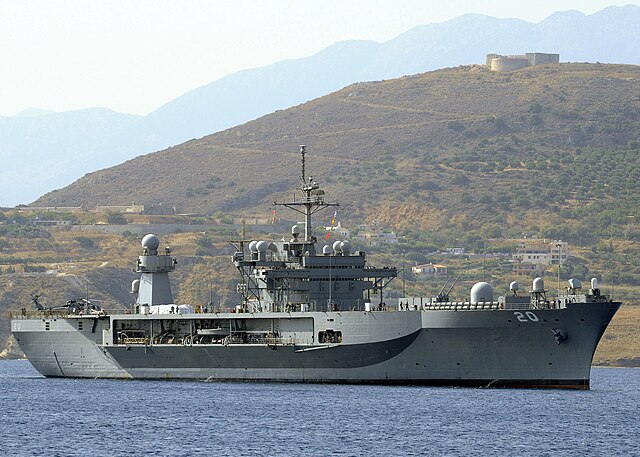
Souda Bay, Crete, Greece (Aug. 28, 2008) — The USS Mount Whitney (LCC 20) arrives for a routine port visit. The Military Sealift Command (MSC) command ship is homported in Gaeta, Italy where she was recently loaded with humanitarian aid supplies destined for the Republic of Georgia. Mount Whitney is currently transiting to the Black Sea for delivery of her humanitarian assistance cargo.
U.S. Navy photo by Mr. Paul Farley
The Blue Ridge-class command ships are important legacy ships that are usable as primary command and control vessels join to ESGs, acting as floating headquarters for fleet commanders. Modernize dmany times over the years, they provide communications, intelligence, and coordination capabilities for major naval operations. Displacement: ~19,200 tons full load, 620 feet (189 meters) long, 23 knots (43 km/h) speed, Crew: c1,200 personnel including command staff. They Can support helicopters (typically MH-60S) for laison.
Class:
LCC-19 USS Blue Ridge (1970), Active 7th Fleet (Pacific).
LCC-20 USS Mount Whitney (1971) Active 6th Fleet (Europe & Africa).
They act as Fleet Command Headquarters for large-scale naval and joint-force missions, are equipped with secure data links, satellite communications, and radar for real-time battlefield awareness. They could provide a vital role in Humanitarian & Diplomatic Missions and are often deployed for disaster relief efforts. Their extensive upgrades ansured their remain operational through at least 2039. No replacement program had been scheduled yet.
 San Antonio class ()
San Antonio class ()
USS San Antonio, New Orleans, Mesa Verde, Green Bay, New York, San Diego, Anchorage, Arlington, Somerset, John P. Murtha, Portland, Fort Lauderdale, Richard M. McCool Jr.

The San Antonio-class amphibious transport dock (LPD)are the most modern modern amphibious warfare ships in the United States Navy, inheritors of old LSDs. They are designed to transport and deploy Marines, landing craft, vehicles, and aircraft in expeditionary missions.
Specs: Displacement: ~25,000 tons full load, Length 684 feet (208 meters), Speed 22+ knots (41 km/h).
Crew: c400 sailors +c800 Marines (up to 1,200 in surge capacity), carries LCACs, AAVs and other landing craft.
The flight Deck can operate MV-22 Ospreys, CH-53E/K, AH-1Z, UH-1Y, and MH-60 helicopters. They also have an advanced Stealth Design with low radar cross-section and reduced infrared signature.
Class: LPD-29 USS Richard M. McCool Jr. is planned to enter service this year LPD-30+ are Future Flight II LPDs TBD currently planned
LPD-28 and beyond are part of the “Flight II” variant, as cost-effective replacements for the legacy Whidbey Island-class (LSDs).
They are capable of Command and Control (C2) with advanced combat systems, sensors, and communication suites and could defend themselves with a RIM-116 Rolling Airframe Missile (RAM), Mk 46 30mm guns, and electronic warfare systems.
 Harpers Ferry class (1994)
Harpers Ferry class (1994)
USS Harpers Ferry, Carter Hall, Oak Hill, Pearl Harbor
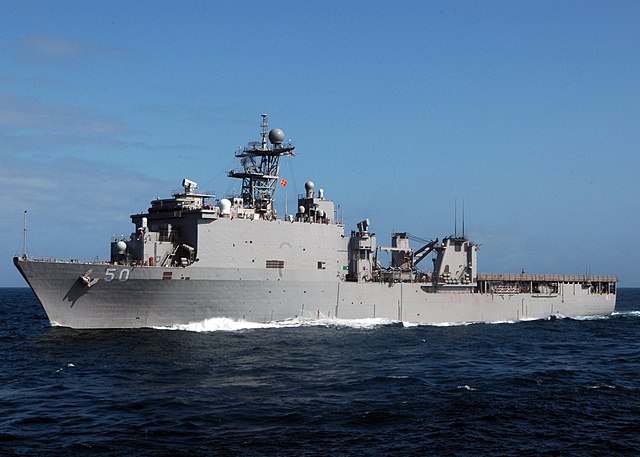
The Harpers Ferry-class dock landing ships (LSD-49) are moderately recent amphibious warfare ships designed to transport and launch landing craft, vehicles, and Marines for expeditionary operations, as modified version of the Whidbey Island-class (LSD-41), with increased cargo capacity at the expense of a reduced well deck.
Specs: Displacement c16,600 tons full load, Length 610 feet (186 meters), top speed 20+ knots (37 km/h).
Crew: c333 sailors +500 Marines, can accommodate two LCACs or alt., supports helicopters CH-53E, MV-22, MH-60S, UH-1Y, AH-1Z.
Self defence includes 2x RIM-116 RAM launchers, 2x Mk 38 25mm chain gun, 2x Phalanx CIWS (Close-In Weapon System), EW suite, chaff etc.
They could carry more vehicle and equipment storage compared to Whidbey Island-class.
They are planned for replacement by the San Antonio-class Flight II (LPD-30+).
 Whidbey Island class (1983)
Whidbey Island class (1983)
USS Germantown, Gunston Hall, Comstock, Tortuga, Rushmore, Ashland
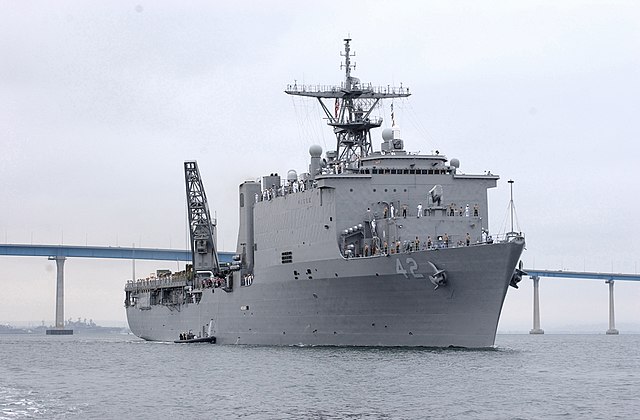
The Whidbey Island class is a class of Dock Landing Ships (LSD) used by the United States Navy. The class consists of eight ships, which were commissioned between 1985 and 1992.
The Whidbey Island class is designed to transport and launch amphibious craft and vehicles, such as Landing Craft Air Cushion (LCAC) and Amphibious Assault Vehicles (AAVs), to support amphibious landings and other operations. They can also serve as a floating base for helicopters and vertical takeoff and landing aircraft.
The ships have a displacement of approximately 15,000 tons and are powered by diesel engines, which give them a top speed of around 20 knots. They have a crew of around 22 officers and 391 enlisted sailors and can accommodate up to 500 Marines.
The Whidbey Island class ships are equipped with a variety of weapons, including two 25mm chain guns, two Phalanx close-in weapons systems, and two .50 caliber machine guns. The ships have seen service in a variety of operations, including the wars in Iraq and Afghanistan, as well as humanitarian missions and disaster relief efforts around the world. They are planned for replacement by Flight II San Antonio class.
Submarines
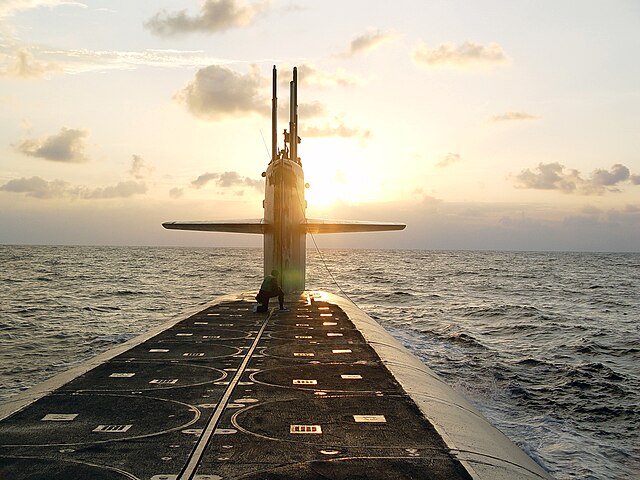
The U.S. Navy operates currently three types of submarines: Attack submarines (SSN), Ballistic missile submarines (SSBN) and guided missile submarines (SSGN). They are all nuclear-powered, enabling stealth and long range, high-speed operations. Depending of the types, they are operating alone in long deterrence patrols (SSBNs) often with swapped crews, or in tactical anti-task force deployments (SSGNs), and .or like SSNs as part of a strike battle group. If both SSNs and SSGNs carried both cruise missiles, only the latter are capable of saturation fire, both as part of an ESG for loing range inland strikes and distant fleet protection. In addition anti-ship, sub-hunting roles, strike (SSGNs) they are also used to gather intel and assist in spec. ops. Current SSBNs operates the Trident nuclear missile.
The Navy currently operates a grand total of 69 submarines:
-29 Los Angeles class SSNs (+2 in reserve)
-3 Seawolf class SSNs
-19 Virginia class SSNs (more on order)
-14 Ohio class SSBNs
-4 Ohio class SSGNs
 Ohio class SSBNs
Ohio class SSBNs
SSBNs: USS Henry M. Jackson, Alabama, Alaska, Nevada, Tennessee, Pennsylvania, West Virginia, Kentucky, Maryland, Nebraska, Rhode Island, Maine, Wyoming, Louisiana. SSGNs: USS Ohio, Michigan, Florida, Georgia
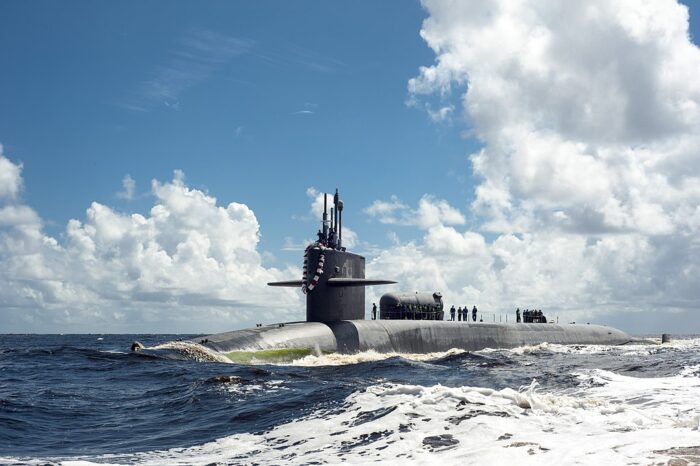
The Ohio-class SSBN (ballistic missile submarines) are the strategic nuclear deterrent submarines of the United States Navy. These nuclear-powered submarines (SSBNs) are designed to carry and launch Trident II D5 intercontinental ballistic missiles (ICBMs), ensuring the U.S. has a second-strike nuclear capability.
Specs: Displacement: 18,750 tons submerged, length 560 feet (170 meters).
Speed: 20+ knots (classified, est.25+ knots), Unlimited range.
Crew: c155 personnel, rotating (2 crews)
Armament: 24x Trident II D5 SLBMs, 4x 533mm torpedo tubes (Mk 48)
The first four Ohio-Class (1981-84) were modernized and converted to SSGN as per nuclear disarmament treaties. They carries a massive number (150+) Tomahawk missile strikes and special operations.
Each Ohio-class SSBN carries Trident II D5 SLBMs with up to 10-12 MIRVs each. They are the guarantor of a “second-strike” capability in case of a nuclear conflict. The use of “Gold” and “Blue” crew rotation maintains a near-continuous patrol cycle in between long overhauls. This maximize their presence at sea at all times. Like current SSNs they are ultra-quiet and are deployed for an average of 90+ days patrols with a single crew, or three months, followed by anotherpatrol and then 6 months in maintenance.
The current Trident II D5 Missile are rated as 7,500+ miles (12,000 km), Mach 24 missiles with a CEP of c90 meters. Per treaty they only carries 4-5 MIRVs each, not the maximal 12 possible. Being a mid-cold war design (1970s) they are long overdue for replacement by the new Columbia-Class SSBN, which delivery is dcheduled FY2031.
 Columbia class SSBN
Columbia class SSBN
USS Columbia, USS Columbia, Wisconsin, 3x unnamed +10 (SSBN-826 – SSBN-840) until 2042
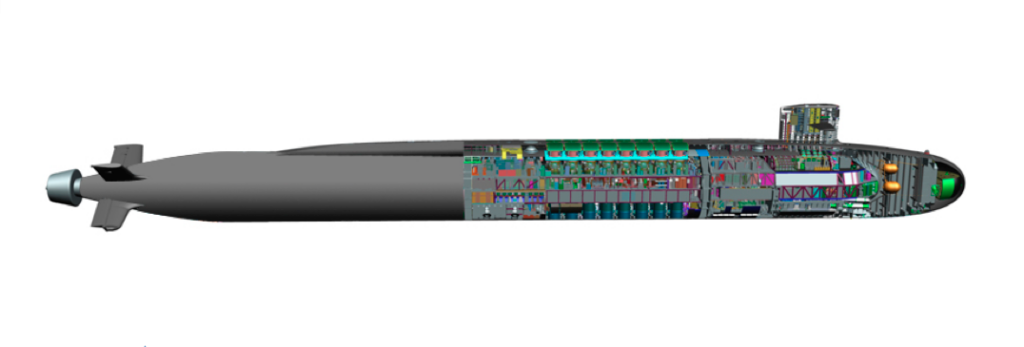
The Columbia-class SSBN is the next-generation nuclear ballistic missile submarine for the United States Navy, designed to replace the aging Ohio-class SSBNs as the backbone of America’s sea-based nuclear deterrent. These submarines will be the most advanced and stealthy SSBNs ever built, ensuring continuous deterrent patrols well into the 2080s. They are as large as the Ohio class but carries far less missiles, from 24 to 16.
Specs:
Displacement: c20,810 tons submerged, 560 feet (171 meters) x 43 feet (13 meters)
Top Speed 20+ knots (classified), Unlimited range, 155 rotating personnel (blue, yellow crews)
Armament: 16x Trident II D5LE SLBMs and 4x 533mm TTs (Mk 48 Mod 7 heavyweight torpedoes)
Total planned: 12 boats to replace 14 Ohio-class SSBNs, designed for a 42-year service life with mid-life overhaul.
The feature a new X-shaped stern control surfaces for better maneuverability, much quieter electric-drive propulsion system, first-ever on a U.S. SSBN, still Advanced sonar and sensor upgrades for detection avoidance.
Their new Trident II D5LE Missile (Extended Life Version) with a classifed range and capabilities. They carried fewer missile tubes (16 vs. 24) to optimize costs and efficiency and only needs a single refueling cycle in their entire lifetime to increase deterrent patrols.
Current planning: 2028: USS Columbia (SSBN-826) begins sea trials, 2031: USS Columbia enters operational service, 2032-2042: Remaining 11 submarines enter service (1 per year). 2080s: Expected end of the Columbia-class service life. Most expensive program in USN history at $132 billion global.
 Los Angeles class SSNs (1971)
Los Angeles class SSNs (1971)
USS Chicago, Key West, Helena, Newport News, San Juan, Pasadena, Albany, Topeka, Scranton, Alexandria, Asheville, Jefferson City, Annapolis, Springfield, Columbus, Santa Fe, Boise, Montpelier, Charlotte, Hampton, Hartford, Toledo, Tucson, Columbia, Greeneville, Cheyenne
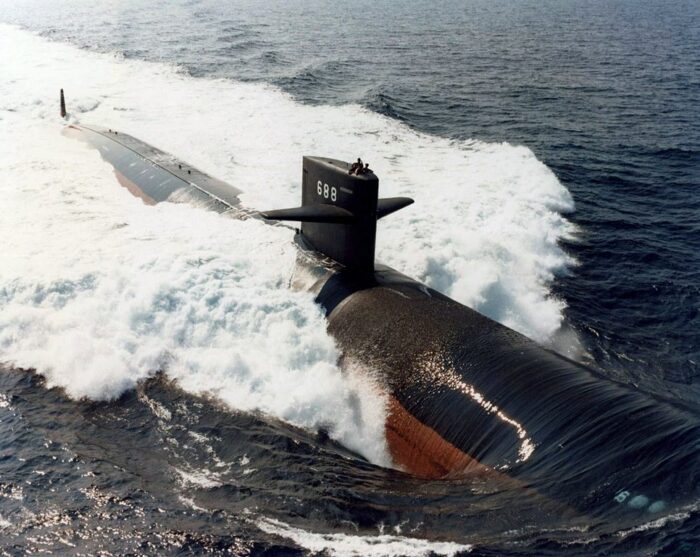
The Los Angeles class were 62 nuclear-powered fast attack submarines (SSN), of which 24 are still currently in service with the US Navy. Called colloquially the “688” class after the lead boat pennant (SSN-688), 62 were built in an uninterrupted serie from 1972 to 1996 which by itself is a record. For that 24 years their large hull enabled many improvements over time, which are identified today in three flights, the latter being Flight III “improved” (Half of today’s US SSN force). This still mades it the world’s largest SSN class, and largest US class since the Pacific Campaign’s Gato/Tench/balao, but with a technological level and cost which makes them a symbol of a remarkable cold war industrial effort. Today, they still account for roughly half of the USN sub force, the rest being three Seawolf and +20 Virginia class.
 Seawolf class SSNs
Seawolf class SSNs
USS Seawolf, Connecticut, Jimmy Carter
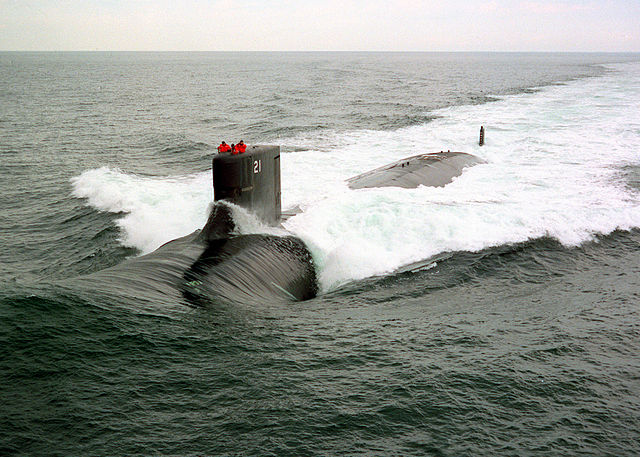
The Seawolf-class SSN is a class of nuclear-powered fast attack submarines (SSNs) in the United States Navy, designed during the Cold War to be the most stealthy, heavily armed, and technologically advanced attack submarines ever built. Only three were completed due to high costs and the end of the Cold War, but they remain among the most capable submarines in the world.
Specs:
Displacement: c9,138 tons submerged, lenght 353 feet (107.6 meters)
Speed: 35+ knots (classified, est. ~40 knots), unlimited range, c140 personnel, Depth est. ~2,000+ ft.
Armament: 8× 660mm TTs, 50 weapons (Mk 48 ADCAP, UGM-109 Tomahawk, UGM-84 Harpoon, Mk 60 CAPTOR mines)
USS Jimmy Carter was modified for Special Operations Capabilities, active since 2005 after many modifications. Her sister were operational in 1997-98.
USS Jimmy Carter (SSN-23) is larger due to her 100-foot-long Multi-Mission Platform (MMP) for special operations, deploy SEAL teams, unmanned underwater vehicles (UUVs) and with extra intel gathering systems.
They are still, according to the US, the world’s Quietest submarines ever built, capable of high speeds, deeper dives, and carrying more and larger torpedo tubes with twice the number of weapons as a Los Angeles-class SSN.
 Virginia class SSN
Virginia class SSN
USS Virginia, Texas, Hawaii, North Carolina, New Hampshire, New Mexico, Missouri, California, Mississippi, Minnesota, North Dakota, John Warner, Illinois, Washington, Colorado, Indiana, South Dakota, Delaware, Vermont, Oregon, Montana, Hyman G. Rickover, New Jersey
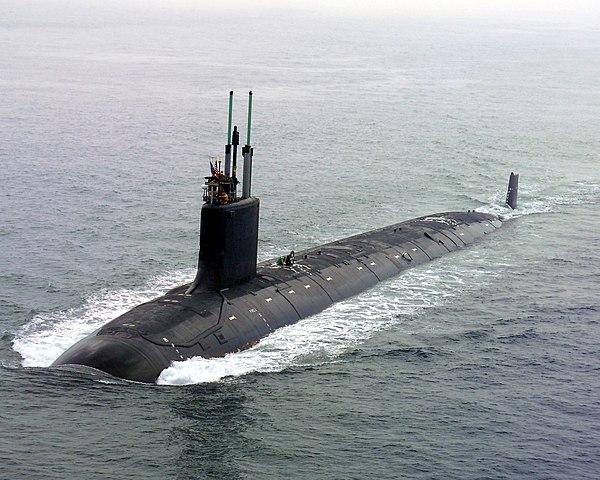
The Seawolf-class SSN is a class of nuclear-powered fast attack submarines (SSNs) in the United States Navy, designed during the Cold War to be the most stealthy, heavily armed, and technologically advanced attack submarines ever built. Only three were completed due to high costs and the end of the Cold War, but they remain among the most capable submarines in the world.
Misc. fleet
 Expeditionary Mobile Base
Expeditionary Mobile Base
USS Lewis B. Puller, Hershel “Woody” Williams, Miguel Keith (ESB-3-5)
 Emory S. Land class sub tenders
Emory S. Land class sub tenders
USS Emory S. Land (AS-39), USS Frank Cable (AS-40)
 Small Boats
Small Boats
Mk 5 SOC: M2 Browning .50 cal Heavy Machine Gun and M240 General Purpose Machine Gun, Transportable by Lockheed C-5 Galaxy only.
SOC-R: GAU-17 minigun, M2 Browning .50 cal Heavy Machine Gun, M240 General Purpose Machine Gun, and 40mm Mk 19 grenade launcher, Transportable by CH-47, C-130, and larger aircraft
RHIB: M2 Browning .50 cal Heavy Machine Gun, M240 General Purpose Machine Gun, and M249 light machine gun
 Avenger-class mine countermeasures ships
Avenger-class mine countermeasures ships
USS Sentry, Devastator, Patriot, Pioneer, Warrior, Gladiator, Dextrous, Chief
The Navy operates eight Avenger-class mine countermeasures ships, with four expected to be retired in 2024. Mine countermeasures vessels are a combination of minehunters, a naval vessel that actively detects and destroys individual naval mines, and minesweepers, which clear mined areas as a whole, without prior detection of the mines. MCM vessels have mostly legacy names of previous US Navy ships, especially World War II-era minesweepers.
 USS Constitution (1796)
USS Constitution (1796)
A special case is the USS Constitution, commissioned in 1797 as one of the original six frigates of the USN and which remains in commission at the Charlestown Navy Yard in Boston. She occasionally sails for commemorative events such as Independence Day.
Read More
https://en.wikipedia.org/wiki/United_States_Navy
https://en.wikipedia.org/wiki/List_of_equipment_of_the_United_States_Navy


 Latest Facebook Entry -
Latest Facebook Entry -  X(Tweeter) Naval Encyclopedia's deck archive
X(Tweeter) Naval Encyclopedia's deck archive Instagram (@navalencyc)
Instagram (@navalencyc)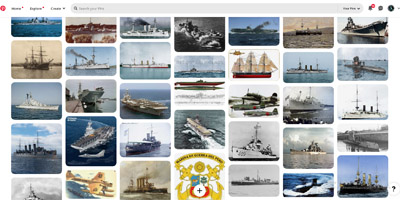

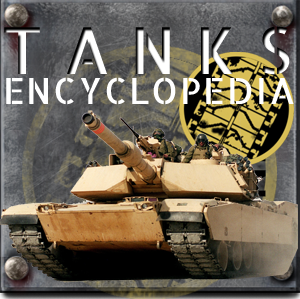
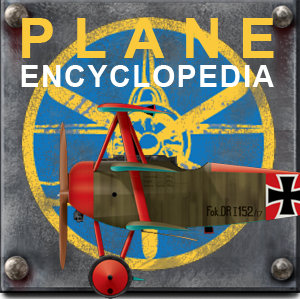
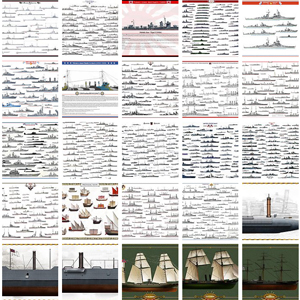

 French Navy
French Navy Royal Navy
Royal Navy Russian Navy
Russian Navy Armada Espanola
Armada Espanola Austrian Navy
Austrian Navy K.u.K. Kriegsmarine
K.u.K. Kriegsmarine Dansk Marine
Dansk Marine Nautiko Hellenon
Nautiko Hellenon Koninklije Marine 1870
Koninklije Marine 1870 Marinha do Brasil
Marinha do Brasil Osmanlı Donanması
Osmanlı Donanması Marina Do Peru
Marina Do Peru Marinha do Portugal
Marinha do Portugal Regia Marina 1870
Regia Marina 1870 Nihhon Kaigun 1870
Nihhon Kaigun 1870 Preußische Marine 1870
Preußische Marine 1870 Russkiy Flot 1870
Russkiy Flot 1870 Svenska marinen
Svenska marinen Søværnet
Søværnet Union Navy
Union Navy Confederate Navy
Confederate Navy Armada de Argentina
Armada de Argentina Imperial Chinese Navy
Imperial Chinese Navy Marinha do Portugal
Marinha do Portugal Mexico
Mexico Kaiserliche Marine
Kaiserliche Marine 1898 US Navy
1898 US Navy Sovietskiy Flot
Sovietskiy Flot Royal Canadian Navy
Royal Canadian Navy Royal Australian Navy
Royal Australian Navy RNZN Fleet
RNZN Fleet Chinese Navy 1937
Chinese Navy 1937 Kriegsmarine
Kriegsmarine Chilean Navy
Chilean Navy Danish Navy
Danish Navy Finnish Navy
Finnish Navy Hellenic Navy
Hellenic Navy Polish Navy
Polish Navy Romanian Navy
Romanian Navy Turkish Navy
Turkish Navy Royal Yugoslav Navy
Royal Yugoslav Navy Royal Thai Navy
Royal Thai Navy Minor Navies
Minor Navies Albania
Albania Austria
Austria Belgium
Belgium Columbia
Columbia Costa Rica
Costa Rica Cuba
Cuba Czechoslovakia
Czechoslovakia Dominican Republic
Dominican Republic Haiti
Haiti Hungary
Hungary Honduras
Honduras Estonia
Estonia Iceland
Iceland Eire
Eire Equador
Equador Iran
Iran Iraq
Iraq Latvia
Latvia Liberia
Liberia Lithuania
Lithuania Mandchukuo
Mandchukuo Morocco
Morocco Nicaragua
Nicaragua Persia
Persia San Salvador
San Salvador Sarawak
Sarawak Uruguay
Uruguay Venezuela
Venezuela Zanzibar
Zanzibar Warsaw Pact Navies
Warsaw Pact Navies Bulgaria
Bulgaria Hungary
Hungary

 Bundesmarine
Bundesmarine Dutch Navy
Dutch Navy Hellenic Navy
Hellenic Navy Marina Militare
Marina Militare Yugoslav Navy
Yugoslav Navy Chinese Navy
Chinese Navy Indian Navy
Indian Navy Indonesian Navy
Indonesian Navy JMSDF
JMSDF North Korean Navy
North Korean Navy Pakistani Navy
Pakistani Navy Philippines Navy
Philippines Navy ROKN
ROKN Rep. of Singapore Navy
Rep. of Singapore Navy Taiwanese Navy
Taiwanese Navy IDF Navy
IDF Navy Saudi Navy
Saudi Navy Royal New Zealand Navy
Royal New Zealand Navy Egyptian Navy
Egyptian Navy South African Navy
South African Navy






























 Ukrainian Navy
Ukrainian Navy dbodesign
dbodesign